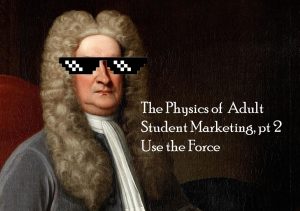by Jeff Ebbing
Southeastern Community College
West Burlington, IA
 [Editor’s note: (I’m the author so I guess it’s technically an author’s note.) This is part 2 of what will soon become required reading in all business schools: How to use Newton’s laws of motion to be a better marketer. Be sure to go back and read part one first. Here’s the handy-dandy link.]
[Editor’s note: (I’m the author so I guess it’s technically an author’s note.) This is part 2 of what will soon become required reading in all business schools: How to use Newton’s laws of motion to be a better marketer. Be sure to go back and read part one first. Here’s the handy-dandy link.]
Well, well. Look who decided to blow past my note and keep reading anyway (you know who you are). Fine. Be that way.
 Before going any further, allow me to call out the Jedi in the room. I bet you’re thinking this is going to be full of clever Star Wars references with the whole “Use the Force” title. Nope. Didn’t go in that direction (I did briefly consider writing in Yoda speak. Decided against it. I did).
Before going any further, allow me to call out the Jedi in the room. I bet you’re thinking this is going to be full of clever Star Wars references with the whole “Use the Force” title. Nope. Didn’t go in that direction (I did briefly consider writing in Yoda speak. Decided against it. I did).
Astute readers will recall that addressing the inertia of doing nothing takes effort but can be overcome with the clever steps heretofore so eloquently described (still sure you don’t want to go back and read part one, wiseguy?). Now that you’ve gotten inside their heads, it’s time for the second step. Or in Newton’s case, the second law: Velocity changes only when subjected to an external force.
Once you get adults to finally give themselves permission to consider the idea of going to college, they’ve already been living their daily lives for years. Get up, go to crappy job, go home, go to sleep, repeat. There is near-zero friction on this well-worn path.
Now you have to get them to do something – anything – to break their routine and start a two-way conversation. That will require some traction.
Your secret weapon? A little bucket of sand.
Lesser marketers might be tempted to just shove an application in their face, convince them to quit their job and sign up for 15 hours starting tomorrow. That’d be like asking them to run head first into a brick wall. Oh, you’d get a few to do it, but most would likely stumble away dazed and confused or have such a bad experience they never come your way again.
Instead, sprinkle some of that sand on the slick spots on their path by leveraging support from existing relationships. Coordinate your efforts with influencers to gain traction and slowly bend the arc. With time they’ll be able to switch paths.
One well-timed tap can drastically alter the course of an object. Consider how Olympic curlers use a tiny broom to adjust the trajectory of a 40 lb stone without ever touching it. That sport has Newton written all over it.
Bring out your inner Olympic recruiter by finding people who already have influence in your prospects’ lives and turn them into advocates. One little word of encouragement from a community leader, a family member, a counselor or a pastor could be all it takes for someone considering college.
Create Opportunities for Engagement
- Partner with area agencies and organizations. Build a network of contacts in workforce development, DHS, voc rehab and community groups. Ask them to spread the word about your college’s programs and services. Chances are they know a slew of ideal candidates (many by name). Remember to reciprocate. These people need help reaching others, too. Know a student who would benefit from their services? Send a referral. When the student wins, everyone wins.
- Get involved and expect nothing in return. Being active in the community humanizes the college, builds trust and, most importantly, dispels your image as that big scary college that can’t possibly be for them. Sponsor a booth at community events, put a float in the parade, host summer movies on the campus lawn, hold adult ed classes in neighborhood centers.
- Build a noncredit to credit pipeline. Anyone who takes a noncredit class – regardless of subject – is (if only for a few hours) a college student. Make your certificates of completion worth framing – better yet, do it for them. Bundle skills classes into a certificate series with a basic credential or endorsement. Invite credit instructors to do a demo or teach a lesson for a little soft-sell recruiting.
Adults know deep down that an education will help their situation. Once they’re comfortable with the possibility of going to school, enlisting external forces to help coax action out of their thoughts will get them on the new path to their future. Because, science.
Congratulations! They’re onboard and enrolled, but now comes the hardest part: helping them finish.
Will Newton’s three-act play be a comedy or a tragedy? Tune in next time for the thrilling conclusion, The Physics of Adult Student Marketing: Over, Through and Around.
And will you just go back and read part one already?
Jeff Ebbing is the director of marketing and communications at Southeastern Community College in West Burlington, Iowa, and NCMPR’s District 5 director.


STAY CONNECTED